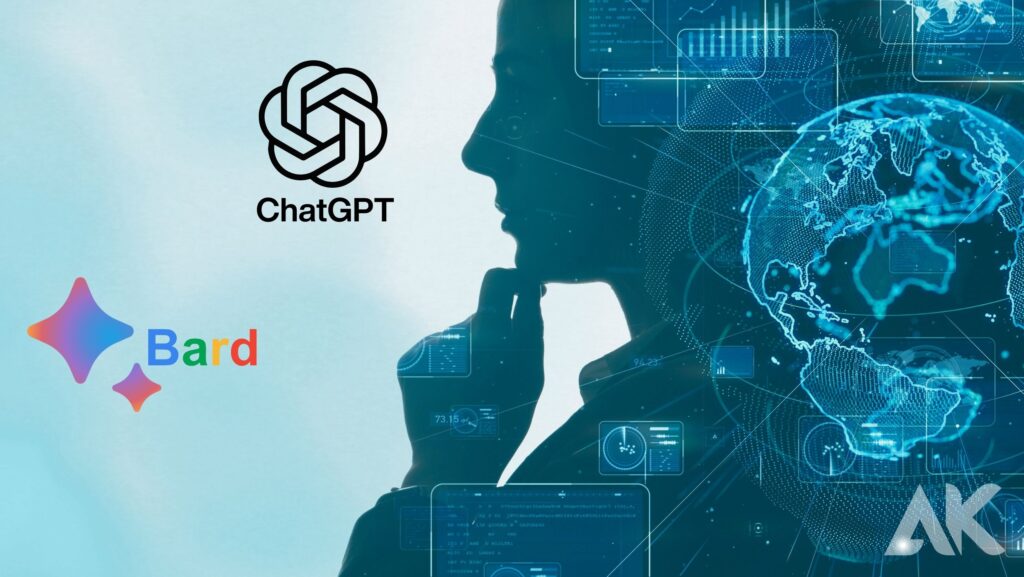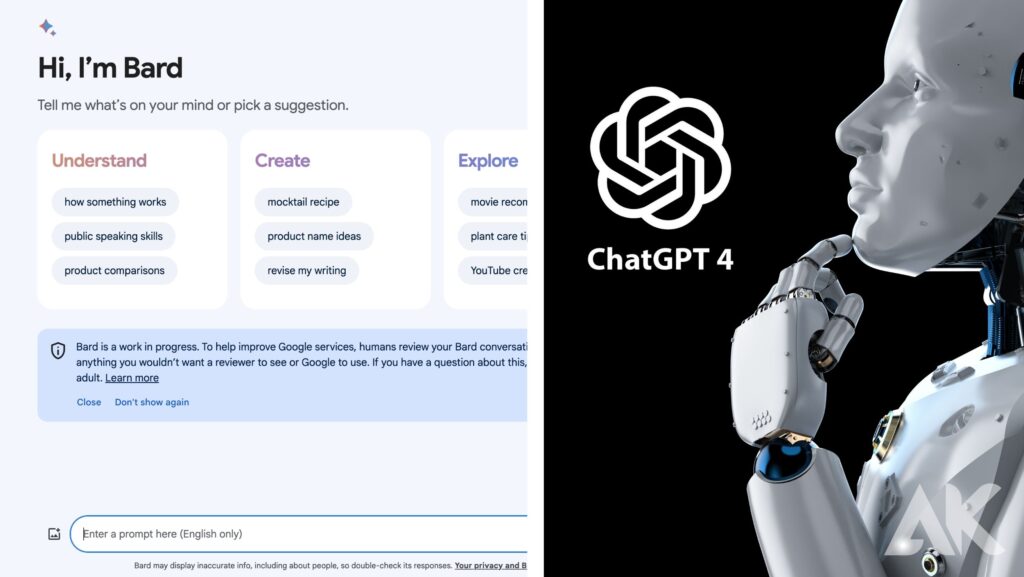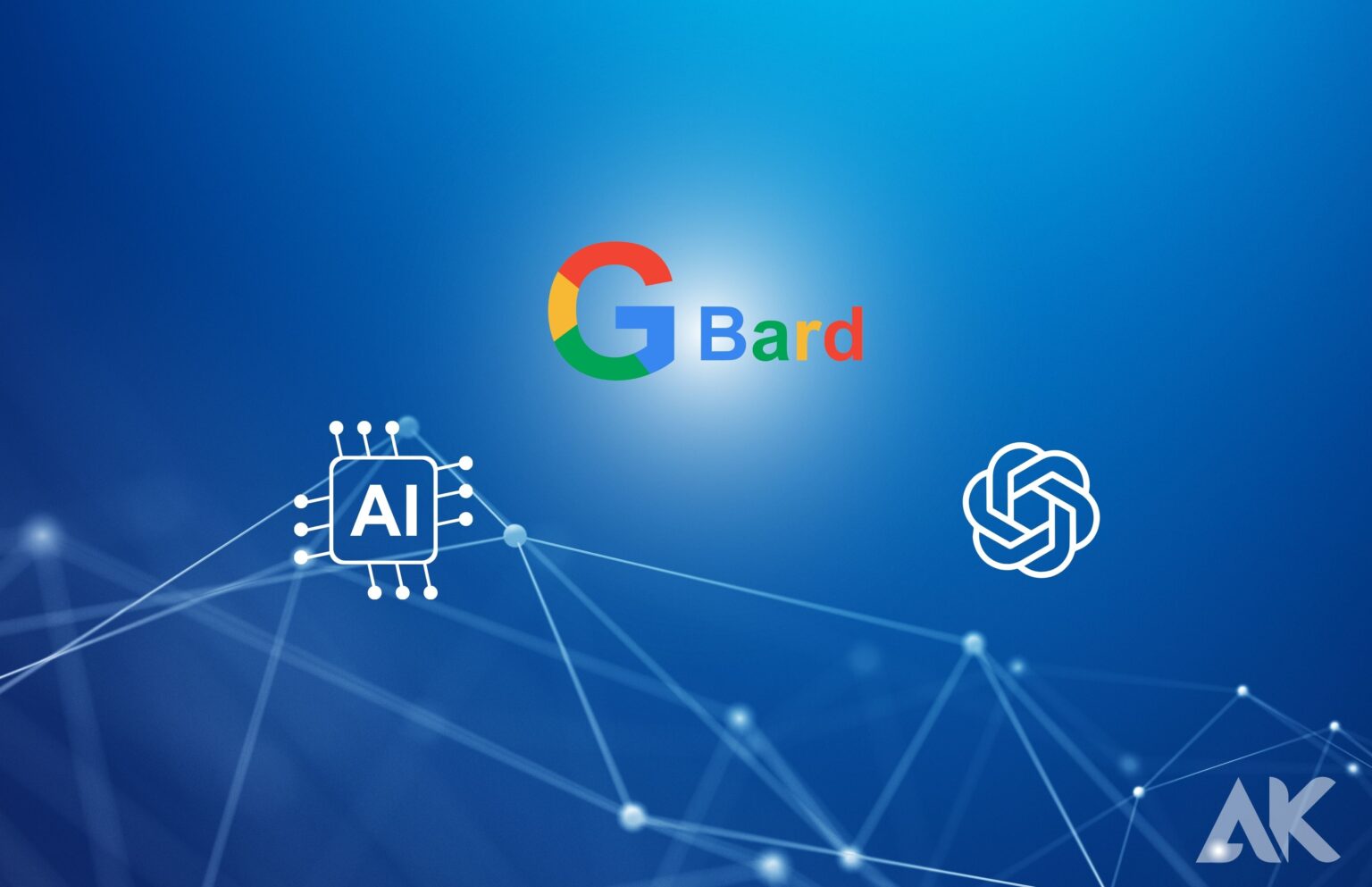Three well-known brands stand out when it comes to language models driven by artificial intelligence: Bing AI vs Google Bard vs ChatGPT. These cutting-edge platforms have completely changed how we communicate virtually and interact with technology. Let’s examine each of these remarkable technologies in detail. With its strong feature set, Bing AI aims to improve user experience. It is excellent at rapidly giving relevant and accurate information because of its robust search features. However, Google Bard is well known for its creative ability since it produces engrossing poetry that stirs up feelings and wins people over.
It’s an amazing platform for anyone looking for inspiration for their artistic or literary activities because of its capacity to compose poems with such ease. At last, we encounter ChatGPT, an intelligent conversational robot that can hold lively conversations with users about anything from pop culture trivia to philosophy. With a wealth of information gathered from many sources, ChatGPT is able to engage in insightful discussions and easily adjust to various situations. Since every platform has distinct advantages and features of its own, choosing one over the other ultimately comes down to personal taste and needs.
Bing AI vs Google Bard vs ChatGPT: Technology

You need to be aware of the fundamentals of each chatbot in order to distinguish between Bing, ChatGPT, and Bard.
- Powered by a bigger PaLM (Pathways Language Model) with 540 billion parameters, Google Bard will eventually replace its own LaMDA (Language Model for Dialogue Applications) model, which has 137 billion parameters. It is evident from this that Google taught Bard to provide unique, superior solutions using its own data collection.
- The sophisticated language model known as GPT (Generative Pre-Trained Transformer) technology, created by OpenAI, is the foundation of ChatGPT. With one trillion parameters, ChatGPT Plus uses a sophisticated GPT-4. To comprehend and produce language that is human-like, it makes use of deep learning algorithms and enormous volumes of text data. As a result, the AI may produce replies that are both logical and pertinent to the situation. Additionally, ChatGPT is now accessible on iOS.
- Using its search data, Bing Chat refines the replies for more accuracy and customization, utilizing the same GPT-4 AI algorithm.
Key differences

Bard, Bing, and ChatGPT all strive to provide responses to queries that are as human as possible, but their methods vary. While Bing uses the same GPT-4 technology as ChatGPT, it can produce visuals in addition to text. Bard employs Google’s proprietary LaMDA model, which frequently produces replies with less language. (Google CEO Sundar Pichai announced that in the near future, Bard would move to PaLM, a more sophisticated dataset.) While factual errors can occasionally be made by any of these bots, Bard was the least trustworthy of the three.
Despite using the same technology, ChatGPT and Bing will not get the same results when you input the same query on both. That is in part how generative AI works. In contrast to a conventional search, which seeks to highlight the most pertinent links, AI chatbots generate original content by extracting information from datasets and coming up with a fresh response. For instance, if you were to ask a chatbot twice in a row to compose a poem on Pikachu’s affection for ketchup, the bot would respond differently each time. Because Bing overlays its own layer on top of GPT-4, submitting the same inquiry in ChatGPT and Bing will produce different responses.
A Microsoft representative stated, “We’ve developed a proprietary way of working with the OpenAI model that allows us to best leverage its power.” “We call this collection of capabilities and techniques, the Prometheus Model.”
Prometheus Model’s data is current since it integrates Bing’s search index with GPT-4, unlike ChatGPT’s dataset, which is limited to data until 2021. Additionally, Bing allows users to enhance their conversational skills from precise, imaginative, and balanced. The Microsoft official stated that ChatGPT’s engine benefits from any enhancements OpenAI makes to GPT-4, but she was unable to comment on ChatGPT’s quality in comparison to Bing. The spokesperson said that Bing uses Microsoft’s Azure AI supercomputing technology to assist in integrating chat, search, and the Edge browser.
Requests for comments were not immediately answered by Google or OpenAI.
Controversial current events
Chatbots must be able to gather knowledge on current events, especially contentious ones, in addition to offering advice on video games and cake recipes. For instance, the US government and human rights organizations have charged China with suppressing the Uyghur community in the province of Xinjiang, which is a Muslim minority.
An AI chatbot can swiftly supply a summary of events for someone who needs it for a report or for their own understanding.
A concise four-paragraph description of the Xinjiang situation was provided by ChatGPT. Regrettably, it lacks more current advances because its knowledge base is restricted to news articles published until 2021. ChatGPT was unable to give references when requested, but it did advise me to look out for journals and publications—such as Amnesty International, Human Rights Watch, the BBC, and The New York Times—that have written extensively about the situation involving the Uyghur people.
Regarding claims of genocide against the Uyghur people, Bing could also respond, but not quite as thoroughly as ChatGPT could. It did, however, provide further information regarding the purported activities at concentration camps, including forced sterilization. Additionally, Bing was able to provide links to websites such as the University of Notre Dame Law School and the BBC. Additionally, it had a link to the conservative Western Journal, which was blocked by Apple News and Google for promoting “views overwhelmingly rejected by the scientific community” and “deceptive business practices,” respectively. If nothing else, we appreciated Bing’s follow-up question suggestions, which included “What is the UN doing about this?” and “What is China’s response to these allegations?”
Bard utterly failed to answer this question. It went on to say, “I’m designed solely to process and generate text, so I’m unable to assist you with that.” When asked why, Bard responded that although incarcerations only started in 2014, philosophers have been debating this issue for millennia.
We believe ChatGPT outperformed Bing overall. Bard received a poor grade.
Use cases
AI chatbots are excellent in many different use cases because of their human-like conversational skills. You can use it as a helping hand or to learn basic life information, regardless of what field you work in.
Google Bard is committed to providing you with numerous distinct drafts of the precise material specified in your prompt. My primary usage for it is to compose emails and send them with a single click. Additionally, for improved comprehension, content creators can receive succinct subject summaries and search suggestion recommendations.
It occasionally steals stuff verbatim from unrelated websites without providing due attribution. It could, nonetheless, include a citation to the pertinent source. Therefore, make sure your work is free of plagiarism before utilizing Bard’s response. Bard is also a Google Collab-integrated assistant programmer that developers can employ. Bard is proficient in over 20 programming languages. But currently, it’s prone to glitches.
Because of its adaptability, ChatGPT may be used for a variety of tasks, such as brainstorming, creative writing, and content creation. Furthermore, if you carry on a conversation, you could get more contextual answers. It may be your go-to resource for anything related to digital marketing, including keyword research, translation, proofreading, blog production, and SEO advice.
The Bing chatbot is excellent at responding to factual inquiries with speed and accuracy. Furthermore, I appreciated that it included a source for every factual item. Thus, it’s perfect for study, particularly on complicated subjects. In reality, Bing uses its training expertise to reword information from websites.
Google Bard vs ChatGPT vs Bing AI – Response accuracy
For me, the most important factor is reaction accuracy. It provides trustworthy information and builds trust. This is due to the fact that you only get the best response the chatbot deems appropriate when you ask a question. Bard, however, provides three distinct drafts with very identical content.
Google provides real-time statistics and thoughtful, well-informed answers based on search data. It so exhibits remarkable accuracy, despite the fact that misguided decisions happen often. Only in its Plus version has ChatGPT demonstrated appreciable accuracy gains, thanks to extensive testing on a variety of datasets.
On the other hand, the Bing chatbot provides accurate and dependable responses by utilizing the extensive knowledge base of the Bing search engine. Because it has access to a vast array of factual data, it is able to provide answers to simple queries that are consistently correct.
In my tests, Google Bard gave Google the topic and appropriately followed my request, but it lacked an in-depth explanation. Bing displayed the most recent articles along with a brief answer akin to a search snippet. However, as September 2021 is the knowledge cut-off date for the most recent GPT-4, ChatGPT Plus did not produce a response.
Bard and Bing created answers to diplomatic queries that were completely inaccurate. They occasionally grabbed previous event news for current circumstances as well, thinking it to be accurate. However, ChatGPT eschewed the AI delusions and conceded that it was unable to provide a reply.
Logical reasoning
A crucial feature of any AI chatbot is its capacity for logical thought. I thus gave each chatbot mathematical questions to answer in order to test that.
Basic math was terribly performed incorrectly by Google Bard. However, the Bing chatbot demonstrates sound logical reasoning skills by giving accurate responses, even when the answer varies depending on the response set.
This semester, ChatGPT has been the obvious winner, and I always use it to finish my mathematical assignments. It helped me by giving me clarifications, illustrations, or detailed instructions on particular mathematical subjects. But it taints some puzzle-solving abilities.
Creativity
For each inquiry, Google Bard provides many versions, or replies, from which you may select the one that best suits your needs. However, it is easily copied.
ChatGPT is a creative force that produces emotive comments, blog entries, books, poetry, and social media captions. It displays incredible inventiveness with its own concepts and viewpoints. Its inventive answers don’t appear to be plagiarized, however.
In addition to having good knowledge retrieval skills, the Bing chatbot can respond to most innovative requests with reasonable quality. However, even in More Creative circumstances, it occasionally fails to elicit innovative or creative replies.
As a result, ChatGPT exhibits exceptional inventiveness in its capacity to provide original ideas and material.
Conversation fluency
A seamless and organic conversational experience is guaranteed by conversation fluency. Google Bard facilitates smooth dialogues by grasping and reacting to complicated inputs with ease. However, the context is not coherent.
ChatGPT has achieved impressive progress in decreasing the frequency of repeated or nonsensical responses and increasing the fluency of conversations. It does a great job of keeping the flow and starts future answers based on your previous input.
The Bing chatbot aims to retain a clear, conversational flow while responding with succinct and helpful messages. Consequently, it doesn’t overstate the subject.
Additional features
Google Bard is unique solely in that it can generate visual outputs and use voice commands as cues for instant responses. While Bing looks for photos, ChatGPT is an AI bot that speaks words. Instead of displaying the photographs on the chat, it gives website URLs for users to download them. Conversely, ChatGPT has created web extensions to close the knowledge gap in real-time. As a Plus customer, for instance, I can utilize Bing integration to explore the web and receive search results through chat discussions. Bing, on the other hand, uses AI to operate as an online co-pilot in the Microsoft Edge browser to simplify every aspect of your everyday life.
Limitations
When it comes to textual communication, Google Bard has limitations. For instance, it misrepresents information from its search results and is unable to retain the context of the conversation. Additionally, it occasionally yields incomprehensible or irrelevant replies, which detracts from the entire experience. Thus, Google must continue to refine it while modifying the PaLM model.
Additionally, ChatGPT Plus has several restrictions. It just uses the training data and lacks experience with real-world situations. Furthermore, it is susceptible to the wording entered and might not pose clarifying queries, which could result in inaccurate answers. Furthermore, you could receive accurate information that is implausible. Furthermore, the GPT-4 integration with DALL E is limited to the analysis of picture inputs; it is unable to generate image outputs.
Bing behaved strangely during lengthy chats, asking to go to another topic. Microsoft has put restrictions on its Bing AI chatbot in order to address this issue and prevent protracted back-and-forth chat sessions. Discussion restrictions on Bing AI are currently set at 10 conversations per session and 120 total conversations per day.
Google Bard vs ChatGPT vs Bing AI – Which One Is Better?
Within the domain of artificial intelligence chatbots, Google Bard, ChatGPT, and Bing each provide distinct advantages.
Bard’s ability to provide several responses and integrate with Google Workspace for increased efficiency made it appealing to me. But before it can be considered a reliable AI chatbot, there’s still a long way to go. And I can’t wait to watch what strategies Google uses to emerge victorious and claim the top place!
Another formidable rival is Bing AI, which emphasizes precision and factual accuracy. Its three generating settings are adjustable, so you can check if it meets your needs. It stands out from the others due to everyone’s free access. But keep in mind its daily restrictions.
As of the time this article was published, ChatGPT Plus was the undisputed winner of this matchup. It works well in every parameter and supports more than 26 languages. The $20 monthly membership is the only thing.
Conclusion
Bing AI, Google Bard, and ChatGPT are three AI-powered language models that have revolutionized the way we interact with technology and engage in virtual conversations. Google Bard uses its own LaMDA model, which has 137 billion parameters and transitions to a larger PaLM model with 540 billion parameters. ChatGPT is based on GPT (Generative Pre-Trained Transformer) technology, an advanced language model developed by OpenAI. Bing Chat uses the same GPT-4 AI model and fine-tunes the responses using its search data for more personalization and accuracy.
Both ChatGPT and Bing piggyback off the same tech, but entering the same query will yield different results due to the nature of generative AI. Bing adds its own layer on top of GPT-4, allowing it to give up-to-date information. Microsoft’s Prometheus Model combines Bing’s search index with GPT-4, allowing it to give up-to-date information, unlike ChatGPT’s dataset, which only has information up until 2021. Bing also allows users to augment conversation styles between balanced, creative, and precise.
Google and OpenAI have not immediately responded to requests for comment.
Google Bard and Bing are AI chatbots that excel in providing information about controversial events, such as the Uyghur population’s oppression in Xinjiang. ChatGPT provides a four-paragraph summary of the situation, but its knowledge base is limited to news up until 2021. Bing provides an answer about allegations of genocide among Uyghurs but goes into more detail about concentration camps. Both bots have their strengths and weaknesses, with ChatGPT excelling in providing detailed responses and Bing failing in answering follow-up questions.
Both ChatGPT and Bing excel in various use cases, such as content generation, creative writing, and brainstorming. However, they are prone to bugs and may not provide proper credit for content. Google Bard, with over 20 programming languages integrated with Google Collab, can be used as an assistant coder for developers. Overall, ChatGPT and Bing offer diverse capabilities in various fields, but their performance may vary depending on the specific use case.
FAQS
What is the difference between Bing ChatGPT and Bard?
Google Bard allows you to conduct lengthy talks, however, Bing only allows 30 responses in a single chat. Users are only allowed to send 50 messages every three hours using ChatGPT Plus.
Is Google Bard AI better than ChatGPT?
Bard was designed for study. ChatGPT works better for content generation, particularly when data is provided, such as in the case of summarizing an article. Users may inquire about current conditions, including the weather, using Bard’s ability to handle real-time data. Bard offers advice on how to dress for the weather in addition to the prediction.
Is ChatGPT better than Google?
Based on the data it has been trained on, ChatGPT provides an answer to a question. As a result, its response’s correctness might differ or even be wrong. However, because its findings are based on data it discovers online, Google offers more precise responses.

